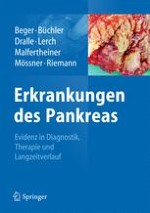
2013 | OriginalPaper | Buchkapitel
1. Pathogenese und Pathophysiologie der akuten Pankreatitis
verfasst von : Matthias Sendler, Julia Mayerle, Markus M. Lerch
Erschienen in: Erkrankungen des Pankreas
Verlag: Springer Berlin Heidelberg

2013 | OriginalPaper | Buchkapitel
verfasst von : Matthias Sendler, Julia Mayerle, Markus M. Lerch
Erschienen in: Erkrankungen des Pankreas
Verlag: Springer Berlin Heidelberg